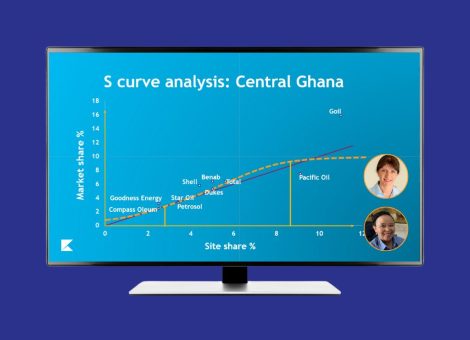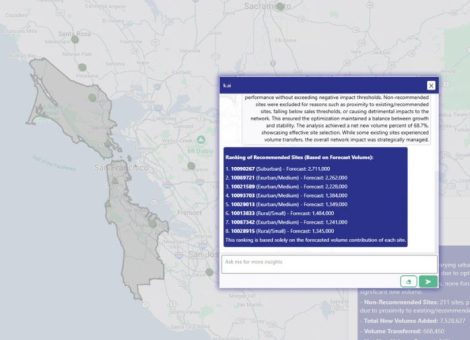Directional fuel price decision-making
Causes of market volatility
Due to current events, global markets are experiencing exceptional levels of volatility. This said, there are many reasons markets experience sudden price changes, and fuel retailers are not strangers to volatility.
Deregulation
Market deregulation can occur for a variety of reasons, but very often emerging markets begin the process due to political or economic pressures. The speed and degree to which deregulation is enacted will shift based on these pressures as well.
When the deregulation process begins, instability takes over. In an unstable market, price controls will be lifted and there is a chance that competition will start to increase, which leads to market uncertainty.
Once volatility develops, it’s very hard to get away from it. Within these markets, it’s not unusual for a restorative pricing cycle to develop. This is characterized by very frequent price reductions in a single day in an attempt to chase volume, to the point where margins are unsustainable. When this happens, a retailer will then “restore” retail prices to a level where margin is more acceptable and the cycle repeats.
- Read more about how deregulation can unfold for fuel retail markets, and what it can mean for fuel pricing processes.
Level of maturity
Volatility doesn’t stem only from deregulation — all markets sit somewhere on the maturity scale, and can naturally move towards volatility. These levels are:
1. Stable
In a stable market, or phase one of maturity, there is no opportunity to differentiate your site based on price, meaning it is critical that you focus on the six volume magnets: location, market, brand, facility, merchandising, and operations.
2. Unstable
As markets begin to mature, instability can set in. As price controls are lifted and competition increases, you may find that there is uncertainty among all major players.
3. Competitive
As new competition is introduced, it becomes easier to ignore or forget the volume magnets that put you in this position. Too often, retailers begin devoting all of their energy to beating the competition based on price alone.
4. Volatile
In a volatile market, volume and margin become a growing challenge. This is the time to maximize. You’ve traveled through the process of refinement and optimization and are ready to get the most from the value you have built at your site.
As retailers and their markets progress through the phases of market maturity, competition and price volatility increase. Because there is a lack of uniformity in how this can unfold, a retailer who is unprepared for its market’s varied competition levels may experience diminished performance.
- Read more about navigating the levels of market maturity in the fuel retailing industry.
Global economic crisis
An unprecedented series of events this year have brought oil prices crashing down. With the OPEC alliance weakening, and varying degrees of travel restrictions imposed worldwide, such volatility represents an incredibly uncertain time for fuel retailers.
Automating processes can play an important role in keeping fuel retailers compliant in these situations, and ensuring that any actions taken during such a high stress period adhere to market rules. Centralized, automated tracking and reporting is crucial.
- Read how to protect your network against volatility and give yourself more time to react during times of global crises.
The role of data in fuel pricing decision-making
Data is essential to price decision-making, but during times of extreme market uncertainty, its role is critical. Pricing processes need to be increasingly fast-moving and wholly agile (with minimal guesswork) for retailers to survive.
At times of crisis, pricing becomes absolutely crucial as customers become less concerned with factors like convenience. Fuel retailers need extreme agility in their fuel pricing decision-making processes — and that means both agility in how data is captured, as well as how it is used.
For this, speed and automation are both key.
Understanding your market
First, you need to understand where your sites perform within their markets, relative to both their own potential and to the performance and potential of the competition. This is true in stable and volatile markets.
A Potential Performance Quadrant analysis is invaluable here, allowing you to segment your sites, understand the impact of potential changes, and identify where you can be quick to respond.
PPQ analysis allows you to unlock opportunities and avoid investment pitfalls by showing you individual sites, and your network as a whole, in greater detail. It takes two dimensional site understanding, and turns it into 3D.
- See what a performance potential quadrant looks like
Tracking competitor activity
In times of uncertainty, understanding competitor impact is a great vehicle for data usage.
You need to monitor what the competition is up to throughout the day and over the weekends, so you can price accordingly. If your strategy is not to lead the market down, you will want to be a fast follower to avoid losing customers.
That means assessing raw market data effectively, and deciding how to react quickly. In volatile periods, it pays to be prompt rather than perfect — keeping pace with the market.
Costs and volumes
Thirdly, data can ensure fuel retailers understand clearly the cost of their existing stock and how quickly it is running down. At times of product cost volatility, there are significant decisions to be made in terms of replenishment, balancing the cost of existing product that’s sitting in the tanks with the replacement cost of freshly ordered product.
This is a careful balancing act — fuel retailers should be wary of cutting their prices too quickly and risk damaging their margins. They have two choices; hold out to get a better price, or give up margin to shift volume and replace it with something less expensive.
Understanding volume movement through data is the most effective way you can solve this dilemma. To arrive at an optimum fuel price and implement it quickly, you need intelligent pricing analytics capabilities that work across your entire network of fuel sites.
Machine learning plays a key role, it takes data — your prices, costs, volumes, competitor information, constraints, price rules, volume, and margin targets — and feeds it into an intelligent platform that can weigh the data up and create appropriate recommended outputs.
- Read more about fuel pricing analytics and its capabilities in our blog.
What is directional decision-making?
In times of extreme volatility, and whilst fuel prices are constantly in flux, it’s important not to get locked in indecision.
Moving quickly in the right direction, even if your pricing is not perfect, holds far more value than doing nothing. This is directional decision-making.
The importance of agility
Directional decision-making is, at its essence, agility. Which can simply be responding rapidly to a competitor move or, for more sophisticated retailers, employing an elasticity model to strike the balance between not dropping the price too quickly (to sell off any expensive in-ground product without making a loss), and not being seen by customers to lag behind the market.
Deprioritize perfection or get left behind
Directional decision-making means assessing raw market data effectively, and deciding how to react quickly. In volatile periods, it pays to be prompt rather than perfect.
This approach allows you to keep pace with the market. The market can be forgiving when it comes to lack of perfection. Making no decisions at all is a far riskier approach in times of uncertainty.
- Read more about finding fuel retail opportunities in what can look like a catastrophe in our blog.
Is there such a thing as “perfect” fuel pricing?
When it comes to fuel pricing, there’s no perfect, one-size-fits-all approach.
While a cookie-cutter approach does help influence how a brand is perceived across the board, a one-size-fits-all approach rarely drives maximum return. The problem is, granular micromanagement of thousands of price decisions is also unrealistic.
It is almost impossible for fuel retailers to occupy exactly the same strength and position in every market. There is almost always an exception, or multiple subtle exceptions. Competition isn’t uniform around every one of your locations, for example. Are your competitor brands acting consistently in each of your markets? These factors can impact your pricing.
No perfection in volatile markets
Successful pricing, in times of extreme volatility, takes a large dose of flexibility. It also takes keen market knowledge and human expertise, as well as technology.
It can be tricky enough to achieve pricing “perfection” when markets are stable and you have the luxury of time to run multiple analyses. When markets are in flux, perfection is almost impossible.
As well as agility, pricing success requires forward-thinking leadership, a realistic (and flexible) strategy, analysts who are committed to finding opportunities in the network, and technology that goes beyond automation.
Focus on speed and flexibility
These four pillars help deliver speed and flexibility — the most critical components. Across volatile global markets, speed of execution is absolutely critical to winning additional volume and margin. Fuel optimization and pricing platforms, such as Kalibrate’s, can help calculate the optimal price for every site in your network in minutes, and keep your pricing moving in the right direction.
- Find out more about the four key pillars for pricing success in our blog.
Are there drawbacks to manual fuel pricing?
In short — yes.
Inefficient pricing models and manual analysis processes can cut into your margins and revenue growth. In times of high pressure, reducing manual analysis and allowing your pricing team to focus on making strategic decisions, can be the difference between success and failure.
An eye on compliance
Unfortunately, global emergency situations can lead to sudden shifts in compliance obligations.
For example, in Florida they have a state of emergency pricing rule which dictates that retailers are not permitted to make more margin than the average margin they have experienced over the past rolling 15 days. Fuel retailers, then, must monitor both their margin and the rolling average, determine a price and calculate the margin, and make sure it’s not higher than the 15-day average. In a manual scenario, this is incredibly time consuming and complex.
Automating processes can also play an important role in keeping you compliant, and ensure that any actions you take during such a high stress period adhere to market rules. Your data is key to telling you what’s going on and proving what happened afterwards.
Centralized, automated tracking and reporting is crucial. You don’t want to be scrambling around for answers to why specific decisions were made in a week’s or a month’s time. You need real time tracking around decision making and approvals, to ensure choices are consistent with pricing policy and — if any departures were made — why.
The last thing you want is to be accused of malpractice once the storm has settled. If the fines aren’t enough to put your business in trouble, the reputational damage might be.
- With potential fines running into the millions of dollars, you can’t leave any room for doubt or confusion. Take a look at our compliance checklist for peace of mind.
Lack of automation or alerts
Focusing management efforts on anomalies is only attainable if you can be easily alerted to such anomalies — something largely unattainable with manual pricing.
Fuel retailers can avoid being swept along by market volatility by “managing by exception”; a process by which rules allow for maintenance of a healthy status quo, only challenged when the model shows you it must be.
After all, you don’t necessarily need to change prices six times a day in order to reach your goals, but if you’re still managing price based on manual processes, you could easily believe that to be the case.
- Automation is required for management by exception, but defining your parameters is the first key piece. Read more about managing by exception here.
The benefits of pricing agility
In dynamic markets, where competitor prices can change multiple times a day, being able to apply your price changes at the appropriate speed is essential.
However, even in stable markets where the timing of your pricing changes is unlikely to make or break your retail experience, your algorithm’s ability to consider every data point is still critical to the optimization process.
Agility always has value, but now it’s critical.
Reacting quickly to change
These exceptional market conditions are causing fuel pricing strategists to rethink their position.
To succeed in the coming months, even years, pricing strategists need to learn to be incredibly flexible, to build proactive strategies while still accounting for the need to react quickly to unexpected market turns, to keep a pulse on what’s happening in the marketplace, and to analyze massive amounts of data during the decision-making process.
Staying ahead of the competition
When you plug the immense amount of up-to-date market information into a dynamic, predictive modeling tool, you have the catalyst for a highly competitive, fast-moving market.
Pricing managers and analysts no longer have to rely on slow, manual data collection in the field. They now have tools at their disposal to quickly access that information, draw on various reporting functionalities to gain a bird’s-eye view of the market landscape, and build mature, proactive fuel pricing strategies around it.
You need the data, analytics tools, and experiential knowledge to understand these unprecedented changes coming up in your market and how it will impact you and your competitors. This allows fuel retailers to formulate a solid strategy that will carry them through this unstable landscape.
- Read more about the importance of agility when forming your pricing strategy in our blog.
Identifying opportunities in chaos
Under such extreme market conditions, some fuel retailers are taking the opportunity to rethink their pricing strategies entirely.
Indeed, while markets are in flux, there are opportunities to evaluate and act upon advantages to your competitors’ behavior.
Ask yourself:
- Is there a chance to be highly reactive, where your competitors are slower to act?
- Are there opportunities to get ahead with exceptional market agility?
A fuel retailer working with an industry expert like Kalibrate to identify the risks and opportunities in their network can then apply a new, dynamic approach to pricing, to maximize performance.
While conditions remain uncertain, data can significantly shape your fuel pricing strategy. Its role is virtually unlimited. It can allow fuel retailers to position themselves in the future, better forecast volume, and make stronger decisions about the rest of their sites’ components.
- With decades of expertise in the fuel retail and convenience industry and complex optimization tools, Kalibrate can help you truly optimize your fuel pricing for success.
Read more articles about:
Fuel pricingRelated posts
Fuel pricing
Fuel pricing by exception: When do analysts actually analyze?
Managing fuel prices can be time-consuming, especially when analysts spend much of their day on routine tasks....

Fuel pricing
Middle East / Africa - Fuel network planning: Critical insights
Join our team as we look at the key points of insight that fuel network planners need to consider when making...


